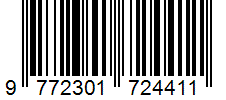DESIGN SOLAR CELL SYSTEM AS SOURCE ELECTRICAL ENERGY FOR MACHINES SALTED FISH DRYER AND FISH CRACKERS
Abstract
ABSTRACT
This research aims to design a solar cell system as an alternative source of electrical energy for drying machines for salted fish and fish crackers. The use of renewable energy is expected to reduce dependence on conventional electricity and reduce production costs for small and medium scale fish processing industries. Research methods include energy needs analysis,solar cell system design, intergration with drying machines, and system performance testing. The system is designed using 300Wp polycrystalline solar panels with a total capacity of 3kWp, a 3000W inverter and a 200Ah lithium battery. The research results show that the solar cell system can meet the energy needs of a drying machine with a capacity of 50kg for 8 hours of operation per day. Drying efficiency is increased by 15% compared to conventional methods, with drying time reduced from 10 hours to 8 hours. Economic analysis shows the investment payback period is 3.5 years with projected energy cost savings of up to 70% per year. This research concludes that implementing a solar cell system in a fish drying machine is a feasible and sustainable solution for the small and medium scale fish processing industry.
This research aims to design a solar cell system as an alternative source of electrical energy for drying machines for salted fish and fish crackers. The use of renewable energy is expected to reduce dependence on conventional electricity and reduce production costs for small and medium scale fish processing industries. Research methods include energy needs analysis,solar cell system design, intergration with drying machines, and system performance testing. The system is designed using 300Wp polycrystalline solar panels with a total capacity of 3kWp, a 3000W inverter and a 200Ah lithium battery. The research results show that the solar cell system can meet the energy needs of a drying machine with a capacity of 50kg for 8 hours of operation per day. Drying efficiency is increased by 15% compared to conventional methods, with drying time reduced from 10 hours to 8 hours. Economic analysis shows the investment payback period is 3.5 years with projected energy cost savings of up to 70% per year. This research concludes that implementing a solar cell system in a fish drying machine is a feasible and sustainable solution for the small and medium scale fish processing industry.
Keywords
Key words: Solar cell, renewable energy, drying maching, salted fish, fish crackers, energy efficiency
Full Text:
PDFDOI: https://doi.org/10.33373/profis.v13i1.7476
Refbacks
- There are currently no refbacks.

This work is licensed under a Creative Commons Attribution-NonCommercial-NoDerivatives 4.0 International License.
E-ISSN 2598-9987
This work is licensed under a Creative Commons Attribution-ShareAlike 4.0 International License.
PROFISIENSI: Jurnal Program Studi Teknik Industri
Building A, 1st Floor, Faculty of Engineering, University of Riau Kepulauan
Jl. Pahlawan No.99, Batu Aji, Batam, Kepulauan Riau
Email: Profisiensi@journal.unrika.ac.id





